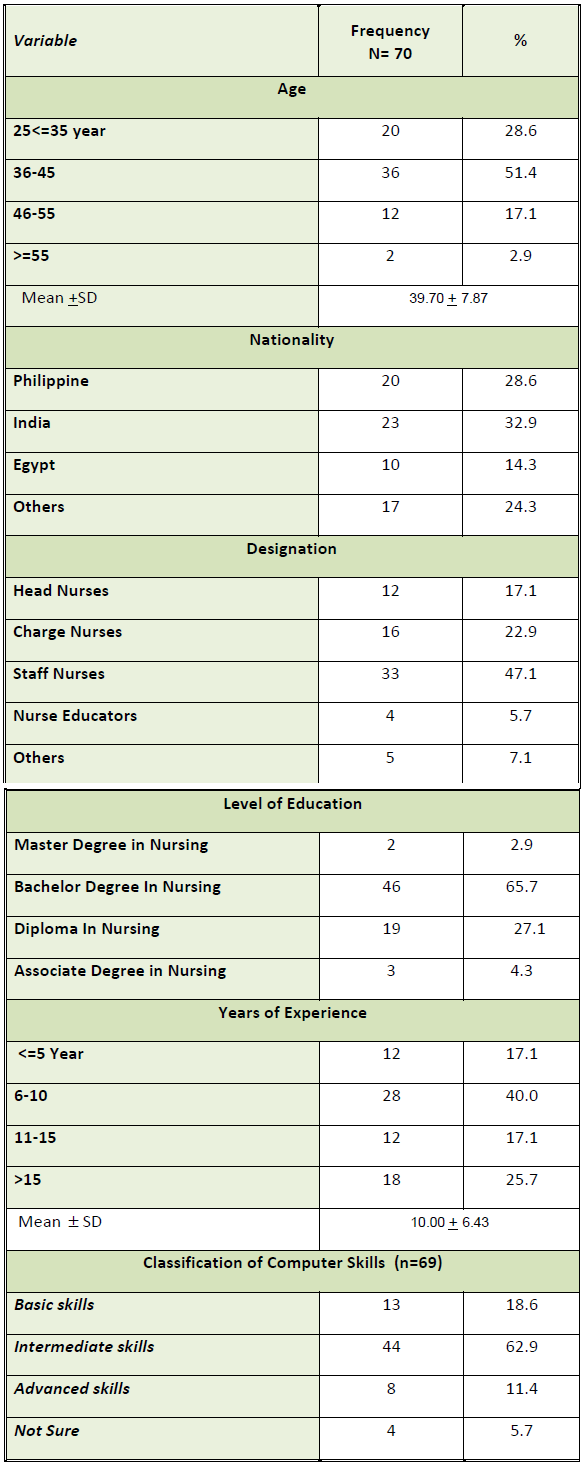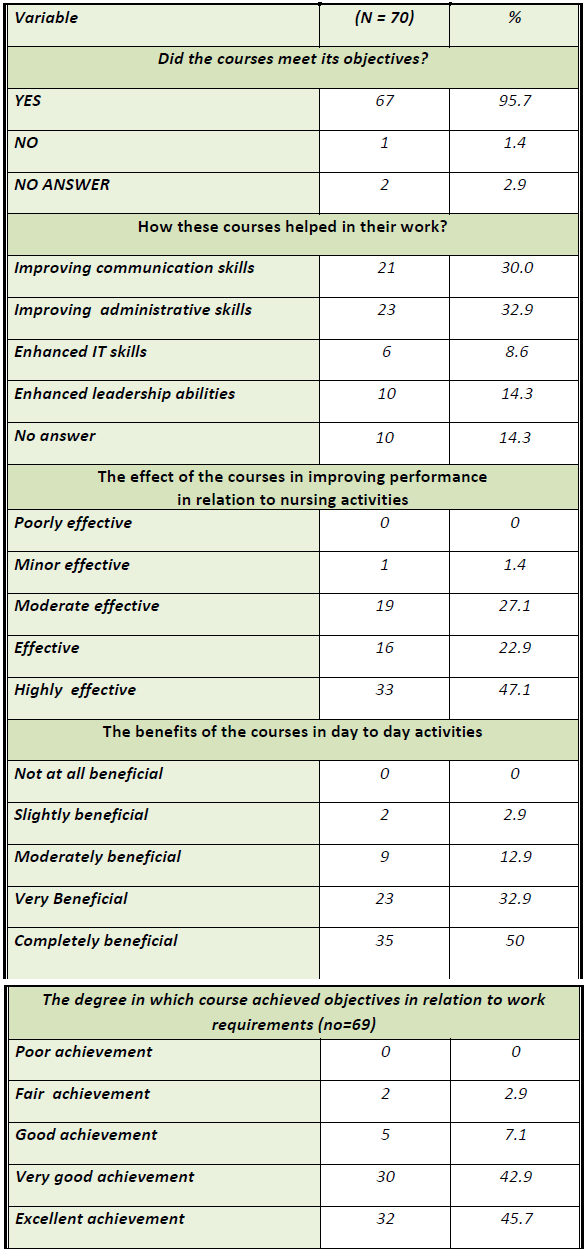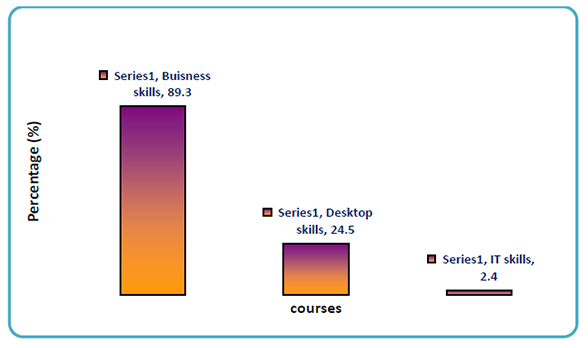The impact of eLearning on nurses’ professional knowledge and practice in HMC
by Dr. Wasmiy A. Dalhem,
Executive Director of Nursing Informatics
and Noha Saleh,
Nursing Informatics Coordinator,
Hamad Medical Corporation, Qatar
ABSTRACT
Continuing education in a clinical environment is challenging for all health care organizations. E-learning was noticed to be increasingly used in Hamad Medical Corporation – QATAR as part of its IT (Information Technology) Strategy implementation which encourages nursing education. Learning opportunities were provided through their enrollment in e-learning courses catered by ictQATAR (the Supreme Council of Information & Communication Technology) to promote their management and leadership abilities, and IT skills. In spite of the eagerness noticed among the staff to enroll themselves in the courses and making use of the educational opportunities offered, there is a shortage of information about the advantages they gained and its reflection on their professional knowledge and practice.
Thus, a descriptive study design was adopted to assess the impact of e-learning on the nurses’ professional knowledge and practice and the factors influencing the effective utilization of e-learning in HMC (Hamad Medical Corporation). 70 nursing staff participated (29% of the population targeted) in responding to the questionnaire survey. The results conveyed the positive impact of integrating e-learning courses as part of the educational opportunities provided for staff. However e-learning as an educational tool still remains comparatively low in usage compared to other tools. The recommendation of the research will reveal the reasons and the solutions for adoption of this tool.
INTRODUCTION
E-learning (electronic learning) is a combination of content and instructional methods delivered via computers to facilitate a building of knowledge and skills. It assists acquisition and comprehension of knowledge by both offline and online interactive technologies. There are a variety of technologies utilized in e-learning, i.e., Internet, intranets, videos, interactive TV and CD-ROM. In addition, there are several approaches to e-learning including: online learning or web-based instruction, computer-assisted instruction and virtual classrooms (Kala, Isaramalai & Pohthong, 2010).
Several studies have emphasized that e-Learning or Internet-based learning, has reaped many positive benefits as an efficient and effective educational tool. The beauty of e-Learning is that it is a unique solution for delivering online learning for nurses despite geographical location, time, or distribution devices. It provides the ability to deliver both learning and information at will – dynamically and immediately. It allows participants to tap into the knowledge of experts and non-experts, and apply their learning beyond classroom walls and into the workplace.
E-Learning engages nurses by building interest and motivation while providing opportunities for active participation and protecting organizational interest with documented training. However, optimal success comes from consistent engagement. The fast-evolving nature of the nursing role and the requirements of registration bodies requires continuing professional development and lifelong learning in all nurses. Kala et al. (2010) stressed that for a number of reasons—most notably staff shortages and geographical isolation—the ability for nurses to undertake traditional face-to-face training has been dramatically impaired, especially in light of ever-growing responsibilities and non-traditional work schedules. Innovative methods like e-Learning are needed to ensure that nurses can continually develop their knowledge and skill set in a time when nursing supply and the demand for qualified nurses continue brink on a growing shortage. E-Learning offers many positive possibilities and advantages that can provide the necessary flexibility in times of massive workplace change. In this time of need, as already noted, it will continue to become more and more of a priority for many organizations, and as this continuum grows, the need for service and retention will keep pace (Kala et al, 2010; Mason & Viner, n.d.; Taylor, Abbott & Hudson, 2008; Kim, Bonk & Zeng, 2005).
Growing sophistication in organizational analytics methods are beginning to correlate investments in human capital (nurses) and technology with organizational success measures such as revenue, profitability, knowledge measurement, retention, protection, and talent attraction. The use of e-Learning provides a foundation for performance, monitoring that makes the correlations between nurses and learning technologies possible (Harun, 2002).
Continuing education in a clinical environment is challenging for all health care organizations. Over the last few years, eLearning has emerged as a practical solution for learning and education in the hospital setting. E-learning was noticed to be increasingly used in Hamad Medical Corporation as part of IT (Information Technology) strategy implementation which supports and encourages nursing education. The Nursing Informatics department has ensured that all nursing staff has 24 hour Internet access in addition to providing Internet café access for nurses in most of the hospitals to encourage the nurses to enhance and update their professional knowledge and continue their education. Learning opportunities were provided through their enrollment in e-Learning courses provided by ictQATAR (the Supreme Council of Information & Communication Technology) to promote their management and leadership abilities plus their IT skills. These courses, were available via the ictQATAR e-learning portal which offers more than 2.500 courses ranging from IT, business, marketing, finance, accounting, leadership, management and so on. The course catalog is divided into three parts: desktop skills, specialized IT and soft skills and contains a full list of courses offered by the e-learning portal. Learners can browse and select and request courses based on their self- assessment and preferences (Qatar, 2015).
In spite of the eagerness noticed among the staff to enroll themselves in the courses and making use of the educational opportunities offered, there is little known about the advantages they gained; how the courses supported their professional knowledge and practice; what obstacles they faced; and what factors influenced their learning process. Exploring these areas is one of the applications of Nursing Informatics experts in to ensure usable integration of IT technology to enhance the professional development of nurses. Thus, the Nursing Informatics department planned and implemented this study to assess what impact e-learning had on the nurses’ professional knowledge and practice and what factors influenced the utilization of this e-learning at HMC (Hamad Medical Corporation).
AIM OF THE STUDY
The main aim of this study was:
- To assess the impact of e-learning on the nurses’ knowledge and practice in HMC.
Other objectives:
- Assess the factors influencing the utilization of e-learning in HMC.
- Assess the need for more e-learning courses among nurses.
- Identify the most accessed topics by the nurses.
METHODOLOGY
Setting
A Descriptive study design was adopted for the present study due to the nature of the research objectives and the data collected to assess the impact of e-learning on nurses’ professional knowledge and practice. The study was conducted at the Hamad Medical Corporation in Qatar.
Sampling
Purposive Survey sampling was used to recruit 70 nursing staff who participated in the e-learning courses provided by HMC.
The exclusive criteria for this study were:
- Staff must have participated in the e-learning courses provided by HMC
- Administrative staff in the nursing department were excluded.
Data Tool
Data for this study was collected through the use of a survey questionnaire, which consisted of two sections:
Section I included demographic data about the participants such as age, educational level, designation, years of experience, facility, and classification of computer skills of participants.
Section II included descriptive data related to the e-learning courses names, benefits, effectiveness, and achievement of objectives in relation to staff day to day nursing activities, preferred methods of learning, and any obstacles faced during the completion of the e-learning courses.
Development of the Tool
The survey questionnaire was developed by the researcher after a thorough review of the literature (Pollex, Johnson & Wood, 2007; Strother, 2002; Bloomsburg University of Pennsylvania, 2006; Corp U, 2012; Lagarto, 2009; Attwell, 2006; McAndrew, Brasher & Hardy). The survey tool was content validated by eight experts in the field of Nursing Informatics and Information Technology to ascertain its relevance .The required modifications were carried out accordingly as directed by these experts.
Pilot study
Before embarking on the full study, a pilot study was carried out with seven staff nurses who participated in the e-learning courses to test the validity and reliability of the data tool. Modifications to the tool were based on the pilot study results.
Ethical Considerations
- Official permission was obtained from the Medical Research Department.
- A database record that contained all participants’ names was prepared prior to the beginning of the survey.
- The proposal of the study targeted 100 staff but due to the low response the questionnaire was disseminated to the whole population (239 staff) who participated in e-learning courses through email. Only 70 (29%) participants responded back after three months of requests for participation.
- The completed questionnaires received from the nursing staff were collected, printed out and kept in a concealed envelope to ensure confidentiality.
- Participating in the research was not mandatory, thus answering the questionnaire and emailing it back to the Nursing Informatics Coordinator was considered to be equivalent to informed consent to participate in the research.
- The researchers abided by the rules and regulation guidelines of the Research Committee of HMC related to intellectual property, conflict of interest, authorship and financial issues.
- The researchers submitted progress and final reports and corresponded with the Research Committee in a timely manner (Principal Investigator).
- The researchers’ responsibility was to maintain original data and consent forms and submit them for review if requested.
- The researcher used scientific rigor and integrity in obtaining, recording and analyzing data; and in reporting and publishing results according to Good Research Practice (GRP).
Data Analysis
Data were entered and verified using the SPSS (statistical package for social science) version 19.0 to perform the tabulation and statistical analysis. Categorical and continuous values were expressed as frequency (percentage) and mean ± SD. Descriptive statistics were used to summarize all demographic and other characteristics of the participants.
Results
The study was mainly concerned with determining the impact of e-learning on the nurses’ knowledge and practice in HMC.
The results of the present study shows:
Section I: Findings related to demographic information of the targeted participants such as age, educational level, designation, years of experience, classification of computer skills of participants.
Section II: Findings related to the described e-learning courses benefits, effectiveness, and achievement of objectives in relation to staff day to day nursing activities, and the nurses’ learning preferences.
Section I: Demographic Results
Table I presents the staff variables influencing the utilization of e-learning courses. The age of the participants ranged between 26 – 63 years with a mean of 39.70 + 7.878 – more than half of the participants fall into the age group 36-45 years. Regarding their educational level, the majority of the surveyed participants had bachelor degree in nursing 65.7% and 27.1 % had diploma degree in nursing. The nationalities of the participants were approximately equally distributed between staff from the Philippines 28.6%, India 32.9% and other nationalities constituted 38.6%.
In the designation field, staff nurses constituted 47.1% of the participants, while head nurses and charge nurses were 71.1% and 22.9% respectively. Years of experience ranged between 1-28 years with a mean of10.00 + 6.43 while 40% of the participants worked around 6-10 years for the Hamad Medical Corporation. 62.9% of the participants reported they had an intermediate level of computer skills according to self-rating and 18.6% had basic computer skills.
Section II: Descriptive Results about E-learning courses
Table 2 illustrates the impact of e-learning courses on nursing staff knowledge and practice. The total number of participant were 70 nurses: the majority (95.7 %) of participants agreed that the courses met their objectives and goals, while only one participant stated that the goals and objectives were not met, and two others did not respond. The staff answers reflected that communication skills and administrative skills were the most improved skills as a result of the e-learning courses (30% and 32.9% respectively); while the least improved skills were IT skills as noted by 8.6% of the participants.
In relation to the effect of the courses in improving performance in nursing activities, almost half (47.1%) of the participants responded that they were highly effective and approximately half were evenly distributed between moderately effective (27.1%) and effective (22.9%). In addition 50% of the participants rated the courses as completely beneficial and the 45.7% rated the courses as excellently achieved the objectives in relation to work requirements.
Table 3 shows the methods of learning preferred by staff for learning nursing knowledge and practice. The methods are:
Method 1: face to face formal training in groups by Nurse Educator -54.3% rated it as the favorable method for learning.
Method 2: face to face individual training from the Nurse Educator was rated as preferred by 34.3%.
Method 3: e-learning was preferred by 42.9%
Methods 4 and 5: The participants were almost neutral towards working through workbooks (method 4) and using the e-library (method 5) as a method of learning.
Method 6: participation in workshops was highly rated by 47.1% of the nurses.
Figure 1: reflects the courses accessed most by the participants. The catalog was divided into 3 parts: desktop skills, specialty IT skills, and Business skills. The majority of the nursing staff (89.3%) were interested in accessing the courses that enhanced business skills while the least (2.4%) selected the IT specialized courses. 24.5% of the participants enrolled in the desktop skills courses.
Discussion
The overall results of the study reveal a positive impact of e-learning courses on the participants’ satisfaction (Table 2) since the majority of participants agreed that the courses had met their goals and objectives except for one participant who stated that they were more on the theoretical aspect thus the objectives of the courses were not met. This result is related to the 62.9% of the participants who rated themselves having intermediate computer skills. Johnson, Hornik & Salas (2008) suggested that computer self-efficacy is important to improve learners interaction mediated via computing technology. For example, highly efficacious learners should be more likely to successfully interact with learning materials and instructors (Seba, 2012; Alzaghoul, 2011; David, Salleh & Lahad, 2012).
Other factors that were assumed to influence the utilization of e-learning courses by the staff such as age, level of education, nationality and years of experience (see Table I) however there seemed to be little relationship between those factors and the e-learning course data (Table 2). The results revealed that age and level of education played an important role in the utilization of the courses since 64.7% of the participants had bachelor degree in nursing. This finding was supported by Manguain (2003) who suggested that e-learning caters best to people who have a relatively high degree of academic and professional education.
As for age being an influencing factor the study showed that more than half of the participants fall between the age group 36-45 years. Gilbert (1996) assumed that than older older people have relatively slower perceptual learning ones. Manguin (2003) noted that in his description of the e-learning users asserted middle aged (35 -45) people account for the greater part of the educational approaches’ audience with 80% of the polled respondents belonging to the lower that 45 age bracket (David et al, 2012; Manguin, 2003; Aixia & Wang, 2012)..
To explore the impact of e-learning courses on the participants’ knowledge and practice in their day to day activities and work requirement; the staff were asked to use a likert scale ( with 1 as the least) and 5 as the most) to rate the effectiveness of the courses; the benefits gained; and the achievements of objectives in relation to the tasks and activities required daily. The results revealed that the majority of staff rated the courses as effective and beneficial, and they accomplished their objective, improved the communication skills with colleagues and patients and boosted administrative skills. These findings were also reflected in Figure 1 which showed that 89.3% of the participants were interested in courses enhancing business skills which included interpersonal communication skills, effective time management, leadership curriculum, management curriculum, excelling at customer service and so on.
E-learning can be combined with more traditional methods for better outcomes as reflected in the findings in Table 3 that showed staff preferred both the traditional way of learning (such as face to face tutoring or lectures and group discussions) in addition to the e-learning courses and workshops. In this aspect, Suen’s research (2005) noted that nurses taking online courses rated the experience as more flexible, stimulating and creative than a traditional classroom lecture. However, Lewis, Davies & Jenkins, (2005) opposed these results and stressed that some studies have indicated that e-learning is more effective. While others have found it to be less effective or demonstrating no difference in outcomes when compared to traditional teaching, our findings suggest that blending e-learning with other traditional method of teaching seem to enrich the learning experience of staff nurses.
LIMITATIONS OF THE STUDY
Some particular study limitations included the late response of the participants which forced the researchers to extend the time frame set for receiving participants’ feedback. As well, a purposive sample technique was used to select the participants.
Another limitation was the decreased rate of responses. The initial target staff group was 100 and due to the decreasing rate of responses the researchers had to target the whole population of staff involved in the e-learning (239 staff). The late and decreased response rate from the participants could be due to several reasons: limited accessibility to computers during duty time, lack of time as a result of the shifting nature of the work; irregular email checking; or a lack of motivation to respond to the questionnaire.
The findings of the study are valid and the returned data was sufficient to meet the requirements for the study objectives, however the results cannot be generalized to the wider population.
CONCLUSIONS AND RECOMMENDATIONS
Embracing e-learning at the Hamad Medical Corporation is not just a good idea but it is necessary step in delivering content through electronic information and communication technologies. The Nursing staff can effectively use the e-learning at work as a technological educational tool and it enables the staff to accomplish their work requirements efficiently. Effective utilization of the available e-learning will provide the needed support and will help to attract and retain the very best health professionals.
Recommendations based on the study results include:
- Continue with e-learning courses incorporated with ictQATAR and ensure accessibility to the staff which provides the opportunity to be exposed to the most advanced ways of learning.
- Embrace e-learning modules built in-house related to Nursing and direct patient care, to ensure optimization of benefits.
- Embed e-learning courses into the Continuing Nursing Education (CNE) system as a recognized learning method that could enhance staff knowledge and skills.
- E-learning courses available online or provided through HMC should be monitored and closely supervised in order to be accredited and reflected in the staff educational and performance records in the administrative system.
- Conduct additional studies on e-learning and the obstacles hindering its effectiveness , including indepth study on e-learning methods and their effect on nursing staff performance and continue research efforts to improve features of e-learning environments.
REFERENCES
Alzaghoul, A. (2011). The implication of the learning theories on implementing e-learning course. The Research Bulletin of Jordan ACM, 11(11), 27 – 30.
Attwell, G. (2006). Evaluating e-learning: A guide to the evaluation of e-learning. Evaluate Europe Handbook Series, 2, Bremen, Germany: Perspektiven-Offset-Druck.
Aixia, D. & Wang, D. (2012). Factors influencing learner attitudes toward e-learning and development of e-learning environment based on the integrated e-learning platform. International Journal of e-Business, e-management and e-learning. 1(3), 264-268.
Bloomsburg University of Pennsylvania (2006). E-Learning Concepts and Techniques: E-Learning Evaluation, Department of Instructional Technology, Bloomsburg University of Pennsylvania.
Corp U. (2012). How to evaluate e-Learning. Philadelphia, PA: Corp U
David, O., Salleh, M. & Lahad, N. (June, 2012). The impact of e-learning in workplace: focus on organizations and healthcare environments. International Arab Journal of e-Technology. 2(4), 203-209.
Gilbert, C. (Oct. 1, 1996). Learning and receptive field plasticity Proceedings of the National Academy of Sciences of the United States of America, 93(20):10546-10547
Harun, M. (2002). Integrating e-learning into workplace. Internet and Higher Education, 4, 301-310.
Johnson, R., Hornik, S. & Salas, E. (2008). An empirical examination of factors contributing to the creation of successful e-learning environments. International Journal of Human-Computer Studies, 66(5), 356–369.
Kala, S., Isaramalai, S. & Pohthong, A. (2010).Electronic learning and constructivism: A model for nursing education. Nursing Education Today, 30(1):61-6.
Kim, K., Bonk, C. & Zeng,T. (June, 2005) Surveying the future of workplace e-learning: The rise of blending, interactivity and authentic learning eLearn Magazine.
Lagarto, J. (2009). Evaluating elearning – from the satisfaction level to evidence of skills in the workplace . In m-ICTE2009 Conference: Research, reflections and innovations Integrating ICT in education. (pp. 5).
Mason, C. & Viner, R. (n.d.) E-learning Background document: AHP.
McAndrew, P., Brasher, A. & Hardy, P. (2004). Determining research questions in e-learning, Networked Learning Conference, Lancaster University, England, UK.
Mungania, P. (2003). Seven e-learning barriers facing employees: Executive summary of dissertation. Academia.edu.
Pollex, H., Johnson, C. & Wood, A. (2007). Why e-learning? Canadian Journal of Nursing Informatics, 2(3), 9-13.
Qatar National e-learning Portal User Manual, http://www.elearning.ictqatar.qa/
Seba, T. (2012). Implications of elearning systems and Self –efficiency on students outcomes: A model approach. Human-centric computing and Information Science, 2 (6), e1 – e11.
Strother, J. (2002). An Assessment of the Effectiveness of e-learning in Corporate Training Programs, E-Journal of IRRODL, 3(1).
Suen, I. (2005). Teaching epidemiology using WebCT: application of the seven principles of good practice. Journal of Nursing Education, 44 (3), 143-6.
Taylor, L., Abbott, P. & Hudson, K. (2008). E-learning for Health-Care Workforce Development. IMIA Yearbook of Medical Informatics.
AUTHOR BIOS:
WASMIYA DALHEM – PhD (UK) in Nursing Informatics
Executive Director of Nursing Informatics Department, Hamad Medical Corporation (HMC).
 Dr. Wasmiya is the first Qatari nurse to specialize in the field of Nursing Informatics. She developed the Nursing Informatics department in 2006 at HMC, the first of its kind in the Gulf and Arab region. She has held various positions within Hamad Medical Corporation, until recently when she was promoted to the position of the Executive Director of Nursing Informatics Department, a reflection of her passion, dedication and hard work. She is a member of the Institute of Healthcare Management UK; British Computer Society UK, and the American Nursing Informatics Association.
Dr. Wasmiya is the first Qatari nurse to specialize in the field of Nursing Informatics. She developed the Nursing Informatics department in 2006 at HMC, the first of its kind in the Gulf and Arab region. She has held various positions within Hamad Medical Corporation, until recently when she was promoted to the position of the Executive Director of Nursing Informatics Department, a reflection of her passion, dedication and hard work. She is a member of the Institute of Healthcare Management UK; British Computer Society UK, and the American Nursing Informatics Association.
Ms. Noha Saleh
Nursing Informatics Coordinator
 Ms. Noha Saleh is a Nursing Informatics Coordinator at Hamad Medical Corporation, Qatar. She received her M.D. from Alexandria University, Egypt.
Ms. Noha Saleh is a Nursing Informatics Coordinator at Hamad Medical Corporation, Qatar. She received her M.D. from Alexandria University, Egypt.
She eventually earned a postgraduate diploma in computer applications, from Annamalai University, India.
She also had an eleven-year long career as a clinical instructor in the Faculty of Nursing at Alexandria University.











